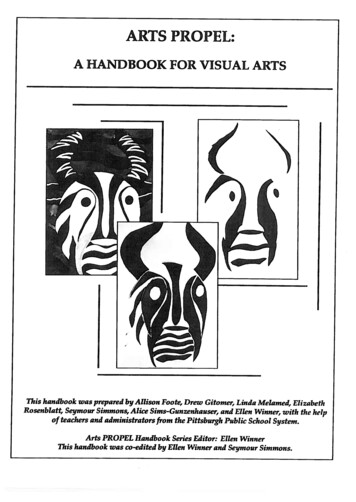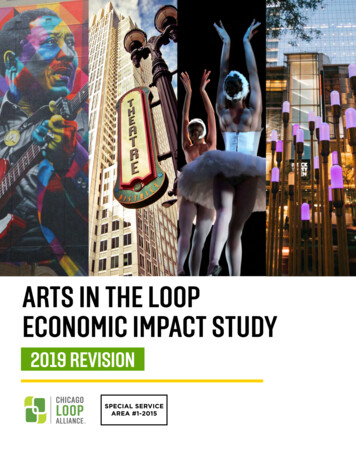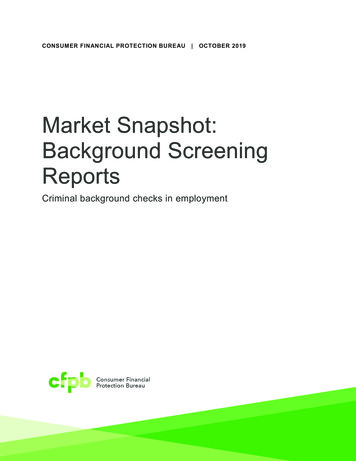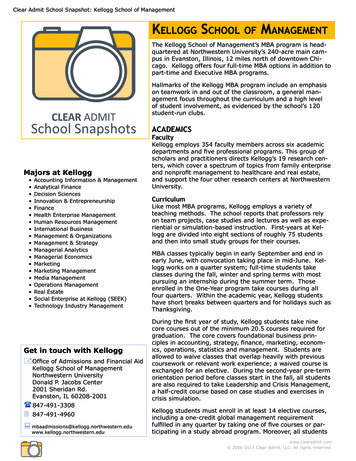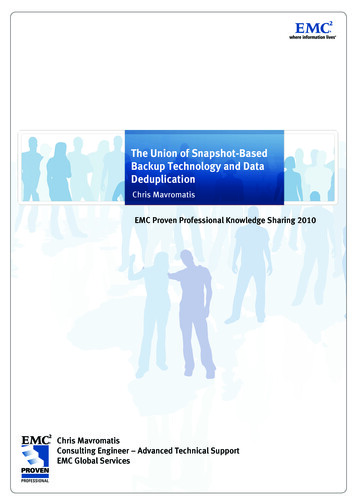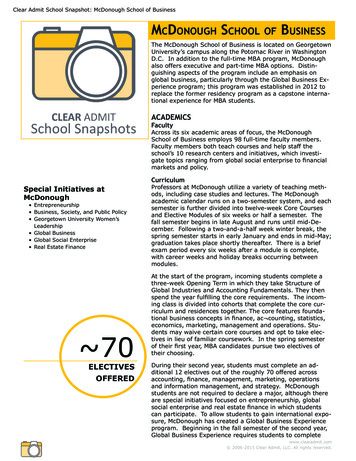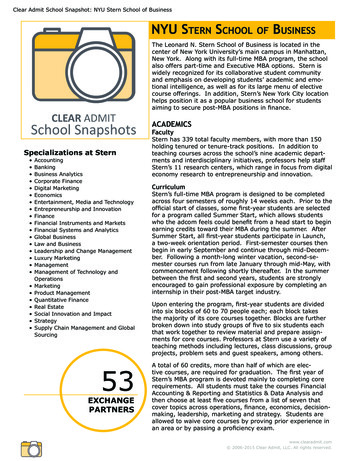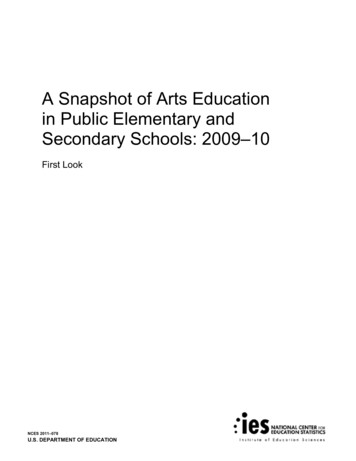
Transcription
A Snapshot of Arts Educationin Public Elementary andSecondary Schools: 2009–10First LookNCES 2011–078U.S. DEPARTMENT OF EDUCATION
A Snapshot of Arts Educationin Public Elementary andSecondary Schools: 2009–10First LookMay 2011Basmat ParsadMaura SpiegelmanWestatJared CoopersmithProject OfficerNational Center for Education StatisticsNCES 2011–078U.S. DEPARTMENT OF EDUCATION
U.S. Department of EducationArne DuncanSecretaryInstitute of Education SciencesJohn Q. EastonDirectorNational Center for Education StatisticsJack BuckleyCommissionerEarly Childhood, International, and Crosscutting Studies DivisionVal PliskoAssociate CommissionerThe National Center for Education Statistics (NCES) is the primary federal entity for collecting, analyzing, andreporting data related to education in the United States and other nations. It fulfills a congressional mandateto collect, collate, analyze, and report full and complete statistics on the condition of education in the UnitedStates; conduct and publish reports and specialized analyses of the meaning and significance of suchstatistics; assist state and local education agencies in improving their statistical systems; and review and reporton education activities in foreign countries.NCES activities are designed to address high-priority education data needs; provide consistent, reliable,complete, and accurate indicators of education status and trends; and report timely, useful, and high-qualitydata to the U.S. Department of Education, the Congress, the states, other education policymakers,practitioners, data users, and the general public. Unless specifically noted, all information contained herein isin the public domain.We strive to make our products available in a variety of formats and in language that is appropriate to avariety of audiences. You, as our customer, are the best judge of our success in communicating informationeffectively. If you have any comments or suggestions about this or any other NCES product or report, we wouldlike to hear from you. Please direct your comments toNational Center for Education StatisticsInstitute of Education SciencesU.S. Department of Education1990 K Street NWWashington, DC 20006-5651May 2011The NCES World Wide Web Home Page address is http://nces.ed.gov.The NCES World Wide Web Publications and Products address is http://nces.ed.gov/pubsearch.This report was prepared for the National Center for Education Statistics under Contract No. ED-04-CO0059/0025 with Westat. Mention of trade names, commercial products, or organizations does not implyendorsement by the U.S. Government.Suggested CitationParsad, B., and Spiegelman, M. (2011). A Snapshot of Arts Education in Public Elementary and SecondarySchools: 2009–10 (NCES 2011–078). National Center for Education Statistics, Institute of Education Sciences,U.S. Department of Education. Washington, DC.For ordering information on this report, write toED PubsU.S. Department of EducationP.O. Box 22207Alexandria, VA 22304or call toll free 1-877-4-ED-Pubs or order online at http://www.EDPubs.gov.Content ContactJared Coopersmith(202) 219-7106jared.coopersmith@ed.gov
AcknowledgmentsThe authors would like to recognize the school principals and teachers in public elementary andsecondary schools who provided data on arts education upon which the report is based. The data werecollected on behalf of the Office of Innovation and Improvement (OII).iii
This page intentionally left blank.
ContentsPageAcknowledgments .iiiList of Tables .viAppendix A Tables .viiAppendix B Tables .viiiFirst Look Summary .1Introduction .Selected Findings .Elementary Schools and Teachers .Secondary Schools and Teachers .1222Tables .3Related Reports .9Appendix A: Standard Error Tables .A-1Appendix B: Technical Notes .B-1Appendix C: Questionnaires .C-1v
List of TablesTable1.2.3.4.5.PagePercent of public elementary schools offering instruction designated specificallyfor various arts subjects, and of those schools, percent reporting the frequencyof instruction and various instructors employed to teach the subject:School year 2009–10 .3Teaching load indicators reported by public elementary school music and visualarts specialists for all classes taught per week by the teacher, by teaching status:School year 2009–10 .4Percent of public elementary school classroom teachers reporting that theyincluded arts instruction into any aspect of their classroom instructionalprogram, and of those teachers, percent who taught arts areas as separatesubjects and percent who incorporated arts instruction in other subject areas:School year 2009–10 .5Percent of public secondary schools offering instruction in various arts subjects,number of teachers on staff reported as arts instructors, and of those teachers,percent reported as arts specialists or other instructors of the subject:School year 2008–09 .6Teaching load indicators reported by public secondary school music and visualarts specialists for all classes taught per week by the teacher, by teaching status:School year 2009–10 .7vi
Appendix A TablesTable1a.2a.3a.4a.5a.PageStandard errors for the percent of public elementary schools offering instructiondesignated specifically for various arts subjects, and of those schools, percentreporting the frequency of instruction and various instructors employed to teachthe subject: School year 2009–10 .A-3Standard errors for the teaching load indicators reported by public elementaryschool music and visual arts specialists for all classes taught per week by theteacher, by teaching status: School year 2009–10 .A-4Standard errors for the percent of public elementary school classroom teachersreporting that they included arts instruction into any aspect of their classroominstructional program, and of those teachers, percent who taught arts areas asseparate subjects and percent who incorporated arts instruction in other subjectareas: School year 2009–10 .A-5Standard errors for the percent of public secondary schools offering instructionin various arts subjects, number of teachers on staff reported as arts instructors,and of those teachers, percent reported as arts specialists or other instructors ofthe subject: School year 2008–09 .A-6Standard errors for the teaching load indicators reported by public secondaryschool music and visual arts specialists for all classes taught per week by theteacher, by teaching status: School year 2009–10 .A-7vii
Appendix B TablesTablePageB-1.Overview of sample selection for school-level surveys, teacher list collections,and teacher-level surveys: School year 2009–10 .B-4B-2.Number of responding public elementary schools and teachers in the studysamples, and estimated number of public elementary schools and teachers thesamples represent: School year 2009–10 .B-6Number of responding public secondary schools and teachers in the studysamples, and estimated number of public elementary schools and teachers thesamples represent: School year 2009–10 .B-7Percent of cases with imputed data for the study samples, and percent of caseswith imputed data the samples represent, by survey and questionnaire itempresented in this report: School year 2009–10 .B-10B-3.B-4.viii
First Look SummaryIntroductionThis report provides selected national data on the status of arts education in public elementary and secondaryschools. 1 The findings are based on information collected through a set of seven surveys. Using its FastResponse Survey System (FRSS), the National Center for Education Statistics (NCES) in the Institute ofEducation Sciences (IES) conducted the surveys during the 2009–10 school year. The elementary andsecondary school surveys collected data on student access to arts education and the resources available forsuch instruction. The teacher surveys collected information on academic preparation, work environments, andinstructional practices of elementary school teachers (classroom teachers, music specialists, and visual artsspecialists) and secondary school music and visual arts specialists. 2This study is the third of its kind to be conducted by NCES to provide national data on arts education. The firststudy was conducted during the 1994–95 school year to provide baseline data on public schools’ approaches toarts education. The second study, conducted during the 1999–2000 school year, included three new surveys onthe educational backgrounds, professional development activities, teaching load, and instructional practices ofelementary school teachers—self-contained classroom teachers, music specialists, and visual arts specialists. 3To update the information from a decade ago, Congress requested that the U.S. Department of Education’sOffice of Innovation and Improvement and NCES conduct a new study that would borrow from and build onthe previous studies. Thus, in addition to including many of the research questions from the previous study, thecurrent study addresses emerging issues in arts education, such as the availability of curriculum-based artseducation activities outside of regular school hours. The current study also provides a more comprehensivepicture of arts education instructors by including two new surveys for secondary music and visual artsspecialists.The purpose of this report is to provide a sample of the findings from the 2009–10 study on arts education inpublic elementary and secondary schools. Specifically, this report presents national data on the following: the availability of music, visual arts, dance, and drama/theatre instruction in public elementary schools, thefrequency of instruction, and the availability of arts specialists to teach the subject; the teaching load of music and visual arts specialists in elementary schools, and the ways in which selfcontained classroom teachers teach arts education as part of their instructional program; the availability of music, visual arts, dance, and drama/theatre instruction in public secondary schools, andthe percentage of arts teachers who are specialists in the subject; 4 and the teaching load of music and visual arts specialists in secondary schools.A second report, planned for fall 2011, will present findings on a broader set of indicators on the status of artseducation in 2009–10 and changes from a decade ago.Because the purpose of this report is to introduce new NCES data through the presentation of tables containingdescriptive information, only selected findings are presented. These findings have been chosen to demonstratethe range of information available from the FRSS study rather than to discuss all of the observed differences orfocus on any particular issue. The findings are based on self-reported data from public school principals andteachers.1Arts instruction refers to the study of creative works in music, visual arts, dance, or drama/theatre, and the process of producing such creativeworks.2Classroom teachers are teachers of self-contained classrooms; these teachers could teach arts areas as separate subjects or incorporate arts areasin other subjects. Arts specialists are education professionals with a teaching certificate in an arts discipline—such as music, visual arts, dance, ordrama/theatre—who provide separate instruction in that discipline.3For results from the 1994–95 study, see Arts Education in Public Elementary and Secondary Schools (NCES 95–082) athttp://nces.ed.gov/pubsearch/pubsinfo.asp?pubid 95082. For results from the 1999–2000 study, see Arts Education in Public Elementary andSecondary Schools: 1999–2000 (NCES 2002–131) at http://nces.ed.gov/pubsearch/pubsinfo.asp?pubid 2002131.4Secondary schools were asked to provide information about arts education courses and staff for the 2008–09 school year since the survey wasmailed in early fall 2009, when some schools might not be able to provide this information for the 2009–10 school year.1
All specific statements of comparisons made in the bullets have been tested for statistical significance at the.05 level using Student’s t-statistics from two-tailed tests to ensure that the differences are larger than thosethat might be expected due to sampling variation. Adjustments for multiple comparisons were not included.Many of the variables examined are related to one another, and complex interactions and relationships have notbeen explored. Tables of standard error estimates are provided in appendix A. Detailed information about thesurvey methodology and analysis variables is provided in appendix B, and the questionnaires for the 2009–10study can be found in appendix C.Selected FindingsElementary Schools and Teachers In 2009–10, most of the nation’s public elementary schools offered instruction that was designatedspecifically for music and visual arts (94 and 83 percent, respectively) (table 1). In comparison, 3 percentof elementary schools offered instruction that was designated specifically for dance, and 4 percent offeredinstruction that was designated specifically for drama/theatre. Of the elementary schools that offered music, 93 percent offered instruction in that subject at least once aweek, and 91 percent employed arts specialists to teach the subject in 2009–10 (table 1). Of the elementaryschools that offered visual arts, 85 percent offered instruction in that subject at least once a week, and84 percent had arts specialists teaching the subject. In elementary schools that offered dance, 53 percentoffered instruction in that subject at least once a week, and 57 percent employed arts specialists to teachthe subject. In elementary schools that offered drama/theatre, 58 percent offered instruction in that subjectat least once a week, and 42 percent had arts specialists teaching the subject. Music specialists and visual arts specialists in elementary schools reported their teaching load for allschools at which they taught during the most recent full week of teaching in the 2009–10 school year(table 2). On average, full-time music specialists spent 22 hours per week teaching 25 different musicclasses (i.e., different groups of students), with a class size of 19 students. On average, full-time visual artsspecialists spent 22 hours per week teaching 24 different visual arts classes, with a class size of 22students. Eighty-eight percent of classroom teachers (i.e., teachers of self-contained classrooms) in elementaryschools indicated that they included arts instruction in some aspect of their classroom instructionalprograms in 2009–10 (table 3). Of these teachers, 6 percent taught music as a separate subject, 14 percenttaught visual arts as a separate subject, 3 percent taught dance as a separate subject, and 8 percent taughtdrama/theatre as a separate subject. In addition, among the 88 percent of classroom teachers who includedarts instruction in their classroom instructional programs, 92 percent incorporated music instruction inother subject areas, 97 percent incorporated visual arts instruction in other subject areas, 87 percentincorporated dance instruction in other subject areas, and 53 percent incorporated drama/theatre instructionin other subject areas.Secondary Schools and Teachers Ninety-one percent of public secondary schools reported that they offered music in the 2008–09 schoolyear, 89 percent offered visual arts, 12 percent offered dance, and 45 percent offered drama/theatre(table 4). Public secondary schools reported that arts specialists accounted for 97 percent of the teachers who taughtmusic in the 2008–09 school year (table 4). In addition, arts specialists were reported to account for94 percent of the teachers who taught visual arts, 69 percent of the teachers who taught dance, and73 percent of the teachers who taught drama/theatre in 2008–09. Music specialists and visual arts specialists in secondary schools reported their teaching load for allschools at which they taught during the most recent full week of teaching in the 2009–10 school year(table 5). On average, full-time music specialists spent 22 hours per week teaching 8 different musicclasses (i.e., different groups of students), with a class size of 24 students. On average, full-time visual artsspecialists spent 23 hours per week teaching 7 different visual arts classes, with a class size of 22 students.2
Table 1. Percent of public elementary schools offering instruction designated specifically forvarious arts subjects, and of those schools, percent reporting the frequency of instructionand various instructors employed to teach the subject: School year 2009–10Instruction offered, frequency, andinstructors employed to teach the subjectMusicVisual artsDanceDrama/theatre948334At least once a week .93855358Every day .52‡‡3 to 4 times a week .106#‡1 to 2 times a week .78765148Less than once a week .7154742Arts specialists .91845742Classroom teachers .12213147Other instructors of the subject .7115326School offered instruction .Frequency of instruction1Instructors employed to teach the subject1# Rounds to zero.‡ Reporting standards not met.1Based on the percent of public elementary schools offering instruction designated specifically for music (94 percent), visual arts (83 percent),dance (3 percent), and drama/theatre (4 percent).NOTE: Percentages for the various types of instructors employed to teach an arts subject do not sum to 100 because schools could report morethan one type of instructor for the subject. Elementary school principals were asked whether various types of instructors were available to teacharts subjects, including arts specialists, classroom teachers, and other instructors. Arts specialists are education professionals with a teachingcertificate in an arts discipline—such as music, visual arts, dance, or drama/theatre—who provide separate instruction in that discipline.Classroom teachers refer to teachers of self-contained classrooms; these teachers could teach arts areas as separate subjects or incorporate artsareas into other subjects. Other instructors of arts subjects include other faculty members, volunteers, and Artists-in-Residence (i.e., visual,literary, or performing artists or folklorists who visit the school for an extended period of time).SOURCE: U.S. Department of Education, National Center for Education Statistics, Fast Response Survey System, “Elementary School ArtsEducation Survey: Fall 2009,” FRSS 100, 2009–10.3
Table 2.Teaching load indicators reported by public elementary school music and visual artsspecialists for all classes taught per week by the teacher, by teaching status:School year 2009–10Specialist and teaching load indicatorTaught the artssubject full timeTaught the artssubject part time251619182214241522212213Music specialistAverage number of classes taught per week1 .2Average class size .3Average number of hours per week spent teaching classes .Visual arts specialistAverage number of classes taught per week1 .2Average class size .3Average number of hours spent per week teaching classes .1Respondents were asked to report the total number of different groups or sections taught during their most recent full week of teaching. Forexample, if a music teacher taught chorus to three different groups or sections of first-graders and two groups or sections of second-graders, theteacher was instructed to report five sections or classes of chorus. If the teacher taught chorus to the same group of students multiple times aweek, he/she was asked to count this class only once.2Respondents were asked to report the total number of students in the different classes taught. For example, if a music teacher taught 5 differentgroups or sections of chorus, each with 20 students enrolled, the teacher was instructed to report a total enrollment of 100 for chorus.3Respondents were asked to report the number of hours spent teaching the classes or sections they reported. This does not include time spentpreparing for classes, time spent on arts-related activities (e.g., student performances and art exhibitions), and time spent on non-arts activitiessuch as cafeteria or hall duty.NOTE: Averages were computed across all records in the survey and based on data that were weighted to national estimates. For example, theaverage number of classes taught by music teachers was computed by summing the weighted number of classes taught by all music teachers anddividing by the weighted number of music teachers in the study.SOURCE: U.S. Department of Education, National Center for Education Statistics, Fast Response Survey System, “Survey of Elementary SchoolMusic Specialists,” FRSS 102M, 2009–10; and “Survey of Elementary School Visual Arts Specialists,” FRSS 102VA, 2009–10.4
Table 3.Percent of public elementary school classroom teachers reporting that they included artsinstruction into any aspect of their classroom instructional program, and of thoseteachers, percent who taught arts areas as separate subjects and percent whoincorporated arts instruction in other subject areas: School year 2009–10Approach to teaching artsPercentIncluded arts instruction into any aspect of classroom instructional program .88Taught arts areas as separate subjects1Music .6Visual arts .14Dance .3Drama/theatre .8Incorporated arts instruction in other subject areas1Incorporated music .92Incorporated visual arts .97Incorporated dance .87Incorporated drama/theatre .531Based on the 88 percent of classroom teachers (i.e., teachers of self-contained classrooms) who included arts instruction into any aspect of theirclassroom instructional program.NOTE: Percentages do not sum to 100 because classroom teachers could report teaching multiple arts areas as separate subjects, and they couldreport multiple ways of incorporating arts areas in other subjects.SOURCE: U.S. Department of Education, National Center for Education Statistics, Fast Response Survey System, “Arts Survey of ElementarySchool Classroom Teachers,” FRSS 102C, 2009–10.5
Table 4.Percent of public secondary schools offering instruction in various arts subjects, numberof teachers on staff reported as arts instructors, and of those teachers, percent reportedas arts specialists or other instructors of the subject: School year 2008–09MusicVisual artsDanceDrama/theatrePercent of schools that offered instruction .91891245Number of teachers on staff reported as arts instructors1 .65,90049,7005,60018,000Arts specialists in the subject .97946973Full-time arts specialists in the subject .81865664Part-time arts specialists in the subject .158139All other instructors of the subject .363127Instruction offered and instructors of the subjectPercent of arts instructors who were:1Based on the percent of public secondary schools offering instruction designated specifically for music (91 percent), visual arts (89 percent),dance (12 percent), and drama/theatre (45 percent). The numbers of teachers for the various arts subjects are based on data provided by schoolsand weighted to national estimates. Secondary school principals were asked to report the number of teachers on the 2008–09 staff who taught thearts subjects and the number of instructors who were arts specialists.NOTE: Detail may not sum to totals because of rounding. Arts specialists are education professionals with a teaching certificate in an artsdiscipline—such as music, visual arts, dance, or drama/theatre—who provide separate instruction in that discipline. Other instructors of artssubjects could include, for example, English teachers who taught drama/theatre and physical education teachers who taught dance.SOURCE: U.S. Department of Education, National Center for Education Statistics, Fast Response Survey System, “Secondary School ArtsEducation Survey: Fall 2009,” FRSS 101, 2009–10.6
Table 5.Teaching load indicators reported by public secondary school music and visual artsspecialists for all classes taught per week by the teacher, by teaching status:School year 2009–10Specialist and teaching load indicatorTaught thearts subjectfull timeTaught thearts subjectpart time84242622127422192314Music specialistAverage number of classes taught per week1 .2Average class size .3Average number of hours per week spent teaching classes .Visual arts specialistAverage number of classes taught per week1 .2Average class size .3Average number of hours per week spent teaching classes .1Respondents were asked to report the total number of different groups or sections taught during their most recent full week of teaching. Forexample, if a music teacher taught chorus to three different groups or sections of students, the teacher was instructed to report three sections orclasses of chorus. If the teacher taught chorus to the same group of students multiple times a week, he/she was asked to count this class only once.2Respondents were asked to report the total number of students in the different classes taught. For example, if a music teacher taught 5 differentgroups or sections of chorus, each with 20 students enrolled, the teacher was instructed to report a total enrollment of 100 for chorus.3Respondents were asked to report the number of hours spent teaching the classes or sections they reported. This does not include time spentpreparing for classes, time spent on arts-related activities (e.g., student performances and art exhibitions), and time spent on non-arts activitiessuch as cafeteria or hall duty.NOTE: Averages were computed across all records in the survey and based on data that were weighted to national estimates. For example, theaverage number of classes taught by music teacher
the teaching load of music and visual arts specialists in secondary schools. A second report, planned for fall 2011, will present findings on a broader set of indicators on the status of

